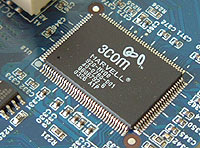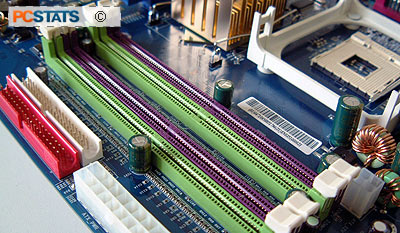Albatron PX875P Pro Motherboard Review
Albatron
have accomplished a lot in the
relatively short time that they've been making motherboards and videocards; the company has good
foresight, and that has helped Albatron win over consumers in an already crowded market.
It also helps that Albatron have taken to producing well equipped mainboards which often
feature IDE/Serial ATA RAID controllers, IEEE 1394 and even high end audio chipsets
as standard.
What happens
then to those consumers who don't want fully loaded motherboard? Why should they spend the
extra money for features that aren't really needed? For example, my main PC has an IDE RAID
controller, onboard 5.1 channel audio, IEEE 1394 and onboard CSA Gigabit LAN...
but they all sit idle. They're nifty features to have, but if I could have gone
with a motherboard without them for a lower price, I would have.
That
brings us to the new Albatron PX875P Pro motherboard, a i875P based
system that is built for someone who wants all the performance of the
Canterwood chipset, but has no need for any of the other features. With
a competitive price point, this makes it a good option for paired down office PC's or
school computers.
The
PX875P Pro motherboard supports all current 533 MHz and 800 MHz FSB 'Northwood' Pentium 4 processors, including
the Pentium 4 Extreme Edition. The manufacturer also states that the
PX875P Pro also supports the 'Prescott' Pentium 4 core - which is known to
be more power hungry. That the PX875P Pro supports Prescott is quite
significant, as not every i865PE/i875P based motherboard on the market right now
does. This is due to the higher power requirements, which are estimated to be
close to 130W.
The only real
extra features of the PX875P Pro include a 3Com Gigabit LAN and 5.1 channel audio.
The board layout is good, for instance there's decent space between the Northbridge
and AGP slot so using  vidoecards with third
party heatsinks, like the Zalman ZM80C-HP is a possibility. vidoecards with third
party heatsinks, like the Zalman ZM80C-HP is a possibility.
As usual,
Albatron have labelled the
various headers and ports on the PCB clearly. If you're confused about where
to connect something, say the IrDA header, the DIY installation guide or manual
will show you. The manufacturer has located the power supply components on the top edge of the PCB, so even the
ATX12V power connector is well out of the way.
I'm sure there are quite a few readers who will be happy to
know that don't need to remove the videocard to install system memory
either. :-)
The clear CMOS jumper is easily accessible, which makes
everyone's life easier if you push the board too far when overclocking. There
are three fan headers, including one just above the AGP slot next to the
Northbridge, perfect for those thinking about active third party
cooling.
 The Albatron PX875P Pro comes equipped with the Intel ICH5 Southbridge, which offers a pretty
good feature set. This motherboard could easily
suit enthusiasts or IT managers looking to build quick office PC's on a
budget.
The Albatron PX875P Pro comes equipped with the Intel ICH5 Southbridge, which offers a pretty
good feature set. This motherboard could easily
suit enthusiasts or IT managers looking to build quick office PC's on a
budget.
With that in mind, active cooling on the
Northbridge would have been ideal too. This is especially evident with Albatron
suggesting that the board can do 1200 MHz FSB on the box! It's hard to hit
300 MHz with any board, let alone with one that has a passively cooled Northbridge
chipset.
The
reason for this is
that when the Northbridge reaches high temperatures it seems to have an affect on
the memory controller. Speaking from personal experience, I notice that at high
FSBs (over 320 MHz), I cannot run my memory at tight timings if the i875P chipset is
too hot. If the Northbridge is cooled down, things improve right away.
|

